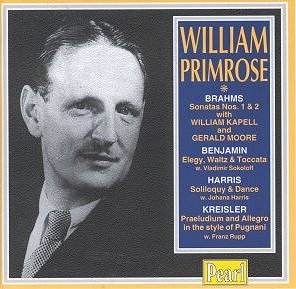If Pearl has a mission beyond the need to survive in
the intensely competitive small market for historical recordings it
must be to present a facsimile of the ideal shellac listening experience.
Declicked but otherwise unfiltered the deep groove whiskery burble soon
sinks out of conscious hearing. The best filtering if we are not to
lose something of ambience or tone is the filter the mind brings to
bear. In the case of this disc the light crackle is in any event discreet
- barely discernible.
The Brahms pairing surprises with the presence of the
fabled American pianist Kapell killed at the age of 31 in a plane crash
and with the lieder pianist Gerald Moore (he also recorded the Rubbra
Second Sonata with Sammons). In both sonatas Primrose is warmth and
vigour personified. There is no blurring of phrasing and while this
accent on punctuation and 'breathing' can, in other hands, seem over-emphatic
or stilted, Primrose's approach and tone remains clear, humorous and
virile. I cannot imagine Brahmsians being disappointed. In fact he strikes
me as a sort of counterpart of Isaac Stern in his Sony recording of
the Brahms Violin Concerto.
The Benjamin work starts with a disenchanted and disenchanting
macabre little elegy. Benjamin's sound world owes more than a modicum
to Prokofiev (cf First Violin Concerto). What I wouldn't give to hear
this work in its orchestral finery preferably with Primrose or alternatively
with Frederick Riddle (who gave the UK premiere in Manchester with Barbirolli).
This work is coeval with the Symphony and both date from the late Second
World War. They share a seriousness and a tragic turmoil and serenity.
Primrose is always spick and span and attacks notes with a belligerent
bow when required. The work is also known as the Viola Sonata and in
orchestral dress as the Viola Concerto.
Roy Harris is another symphonist but whereas Benjamin
produced only one, Harris wrote fourteen. The Harris Soliloquy and Dance
was issued by Victor with the Benjamin (Benjamin 11-9210-; Harris 11-9212-3).
Dance was as much a sympathetic mode of expression to Harris as it was
to Creston and, in his earlier works, Piston. The components of the
diptych are of practically equal length. The faltering soliloquy seems
to speak for the modest crestfallen man and the plangent piano writing
(articulated by the composer's wife) calls up echoes with the Third
Symphony. The Dance capers and ambles along with sidelong glances at
the oft-sniffed at Folksong Symphony (No. 4).
The Kreisler-faked Pugnani piece is Bach-like and could
easily have been adapted from some lost movement from the four orchestral
suites or the violin concertos. It is highly entertaining - just as
much as the oboe and orchestra adaptations made by Arthur Benjamin and
so much in currency at Evelyn Rothwell concerts.
The notes are by Tully Potter who is in his usual fine
form though I would have wished for more specifics on the works … as
well as the artists. In the case of Benjamin and Harris it is quite
plausible that this disc will be of interest for the composer content.
Primrose was born in Glasgow on 23 August 1904 and
died in Provo, Utah on 1 May 1982. His artistry is fairly represented
here but we should remember that he commissioned concertos from Bartok,
Milhaud (No. 2), Rubbra and Fricker.
The transfers have been well handled by Roger Beardsley
who has been favoured with what seems to be mint condition source material
... or perhaps this is a tribute to Mr Beardsley's engineering artistry.
Rob Barnett


